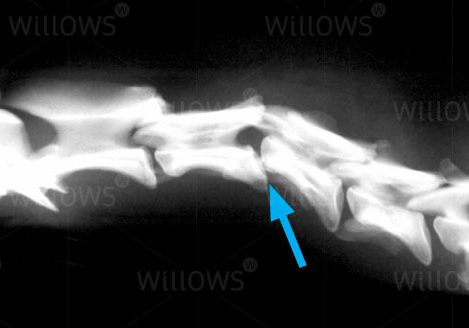Why Should I Bring my Pet to Willows for Treatment of a Spinal Fracture?
Willows is one of Europe’s leading small animal referral centres. Our state-of-the-art hospital is led by internationally renowned Specialists, committed to providing the highest standards of veterinary care. Our Specialist Neurosurgeons are supported by our multi-disciplinary team of Specialists across a number of different disciplines including; Anaesthesia, Diagnostic Imaging and Emergency and Critical Care.
Willows also has a large dedicated team of Vets, Nurses and clinical support staff available 24 hours a day, every day of the year to provide the best possible care for your pet.
What is a Fracture and What is Involved in a Spinal Fracture?
Fractures (breaks) of the spine occur when dogs and cats are involved in road traffic accidents or suffer other major trauma such as a fall or running into a patio door. Spinal fractures are often associated with varying degrees of injury to the spinal cord (the bundle of nerves inside the vertebrae) and, therefore, nerve damage. Although many animals may be paralysed as a result of the fracture, they will often recover, provided that they retain the ability to feel pain and that they are managed appropriately. Some cases can be treated medically, but it is often necessary to consider surgery to stabilise a fractured spine.
In a spinal fracture, the bones (vertebrae) of the spine break (fracture) or come apart from each other (dislocate or luxate). When the bones of the spine fracture or dislocate the associated bone displacement often injures the nerves of the spinal cord.
What are the Most Common Causes of Spinal Fracture?
Fracture of the spine usually occurs as a result of a significant injury, such as being hit by a car, although occasionally the bones in the spine may fracture with minimal, if any, trauma because they are already weakened by a condition such as a tumour (referred to as a ‘pathological fracture’).
What are the Signs of Spinal Fracture?
The signs that develop may vary from only mild weakness through to paralysis. Severely affected patients may become incontinent and lose the ability to feel pain in their limbs and tail.
How is a Spinal Fracture Diagnosed?
Physical examination of the patient by the Specialist may enable detection of instability of the vertebral column or abnormal alignment of the spine. Importantly, examination also enables assessment of the severity of any associated spinal cord injury – in particular, whether or not the patient can still feel pain.
X-rays are often obtained to look for evidence of fracture or dislocation of the vertebrae and are generally sufficient to make a diagnosis in the majority of cases. Occasionally a more advanced imaging technique is preferred to provide additional detail of the spine. CT scanning is particularly good at looking at the bony detail of fractures which may not be apparent on normal x-rays. MRI scanning is not as effective in detecting damage to bones of the spine, however it is excellent for assessing any damage to the spinal cord.
How can a Spinal Fracture be Treated?
Spinal fractures and dislocations are often emergencies due to the associated spinal cord injury and risk of further damage and so need to be treated urgently. Affected dogs and cats are often in significant pain, and care should be taken to avoid the handler being bitten or scratched. Patients should be moved with great caution in case the spine is unstable, as further movement may aggravate the injury and any nerve damage. Strapping the patient to a rigid board may be helpful in some cases.
Some fractures of the spine may be treated conservatively without the need for surgery. This is particularly appropriate in patients with relatively stable vertebrae and minimal spinal cord injury. Conversely, dogs and cats with unstable fractured spines, significant spinal cord injuries and those in severe pain are often best treated surgically. Surgery aims to re-align and stabilise the affected bones. The procedure most often involves placing screws or pins in the bones on either side of the fracture or dislocation and securing them with either a plate or cement.

What can I Expect if my Pet is Treated for a Spinal Fracture?
The outlook in dogs and cats with spinal fracture is mostly dependent on the severity of the spinal cord injury and how the patient is treated. Provided the ability to feel pain in the limbs and tail is maintained and the patient is managed appropriately, the outlook is generally good. Recovery may take a number of weeks (or even months in severely affected cases) and supportive care, including physiotherapy/hydrotherapy exercises, may be necessary. In contrast, patients with spinal fractures that can no longer feel pain are very unlikely to recover, no matter how they are treated as the spinal cord injury is generally severe and irreversible.

X-ray of the neck showing dislocated vertebrae (arrow)

CT scan of the back showing fractured and severely displaced vertebrae

Fractured vertebrae in the neck that have been re-aligned and stabilised with multiple pins and cement

Dislocated vertebrae in the back that have been stabilised with a plate and four screws
To save this page as a PDF, click the button and make sure “Save as PDF” is selected.
Neurology
Find out more
To assist owners in understanding more about Neurological conditions, investigations and treatment we have put together a range of information sheets to talk you through the some of the more common neurological conditions seen by our Specialists.

